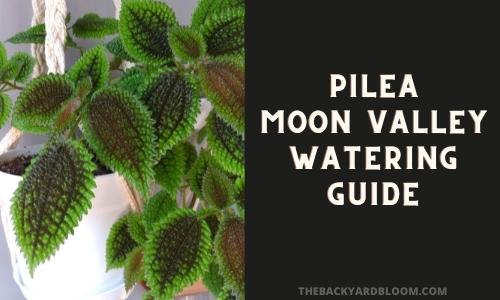Pilea Moon Valley Friendship plants are known to be a bit touchy when it comes to watering them. One common question that new owners of a Moon Valley plant have is: How often should I water my Pilea Moon Valley plant? In this Pilea Moon Valley watering guide we will go over what you should be doing to make sure that your Moon Valley is getting the right amounts of water.
Please see our Care Guide for Pilea Moon Valley Friendship Plants for more info on how to take care of your Moon Valley plant.

Pilea Moon Valley Friendship Plant Watering Guide
Pilea Moon Valley plants need evenly moist soil but not soil that is constantly kept soggy and wet. Between watering you only want the top surface of the soil to be allowed to dry out completely. There are two things that can help tremendously in achieving the right soil moisture levels for these plants.
First, is to make sure that you have the right type of pot. Like all plants, you need to make sure that you have a pot that allows for good drainage. Without drainage in the pot, your plant will be left sitting in soggy soil that can develop bacteria and fungi. This will result in disease and problems such as root rot for your plant.
Second, is to get the right kind of soil. You want soil that is well-draining but that does hold onto some moisture. So soil such as succulent soil would not be a good idea for a Moon Valley plant. I use a regular potting mix for my Moon Valley plant and it is doing great in that soil.
How Often To Water a Pilea Moon Valley
How often you need to water your Moon Valley plant will depend on a few factors.
The biggest influence on your plant’s water needs is going to be the humidity levels. Pilea Mollis plants are from Central and South America, they are used to higher humidity levels. So if you live in the desert you are going to need to be watering your Pilea more often than someone living on the Eastern Coast of the US where humidity remains higher all year.
Seasons will also influence the water needs of your Moon Valley plant. During the spring and summer months, the Pilea Moon Valley is in its growth stage. It will require more water than in the same environment during the more dormant months of the fall and winter. However, the humidity will also change in many areas during this time. I live in an area where it’s 60%+ humidity during the spring and summer and then once fall and winter hit we’re sitting at around 20% humidity. This causes my Moon Valley to actually need more water during the winter than in the summer even though it’s growing.
Use Your Senses When it Comes to Watering a Pilea Moon Valley
The best advice I can give for watering your Pilea Moon Valley is to use your sense of touch and sight. Feel the soil that the plant is in, if the top inch or two is completely dry then it needs water.
If you notice that the leaves of your Pilea Moon Valley are turning brown then this can also be an indication that it needs water. Check out our guide Why Are My Pilea Moon Valley Leaves Turning Brown? to determine if it is in fact water that your plant needs.
Droopy leaves are also another indication that your plant could need more water. See our guide Why Is My Pilea Moon Valley Drooping? to see if your Pilea is drooping due to not having enough water.
Using a Watering Schedule for Your Pilea Moon Valley
If you do want a watering schedule for your plant, the most commonplace to start is to water your plant once a week. But even with using this schedule, you will still need to monitor the soil moisture levels and how your plant is looking to make sure that it is getting enough water or too much water. As the environment changes your plant’s water schedule will have to be adjusted too.
What Type of Water to Use for Watering Your Pilea Moon Valley
Many people will recommend to only water any of your houseplants with distilled water, but sometimes this isn’t always an option. Having to buy distilled water can add extra costs that some people don’t want to have.
When I use tap water I always make sure to run it through a filtering system before using it to water any of my plants. This can help remove some of the minerals and chemicals, but it won’t get rid of it all. For instance, fluoride will still be in the water after it goes through most water filters unless you use a reverse osmosis system which will remove a majority of it.
You could also capture rainwater to use for watering your plants. But again this might not be an option for everyone. It would depend on the outdoor space available to you and if you have access to a system that can capture enough rainwater. For our rainwater, we use the gutter system on our outdoor sheds and have the water run into 35-gallon barrels. But in the winter we don’t have this option so we go back to using filtered tap water.
Related Articles for Pilea Moon Valley Plants
- Does the Pilea Moon Valley (Pilea Mollis) Flower?
- Chinese Money Plant Care Guide (Pilea Peperomioides)